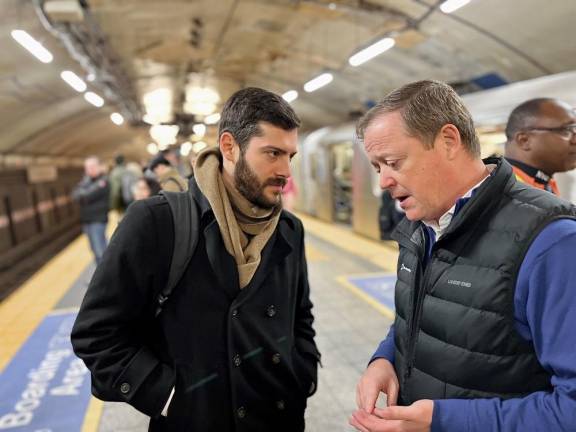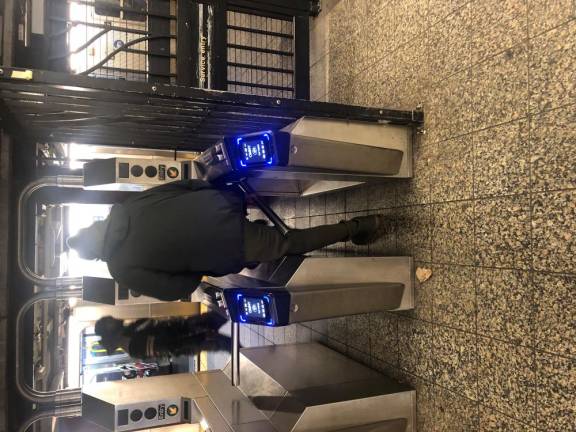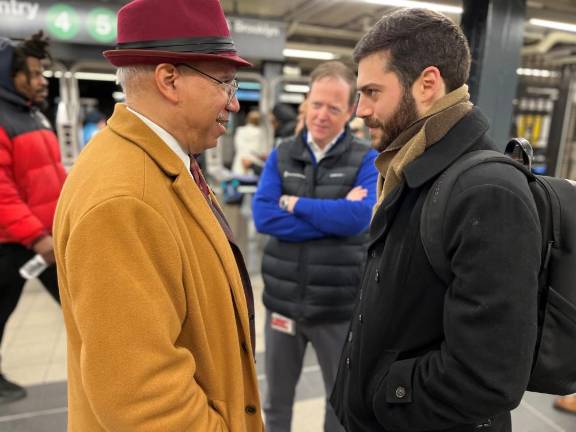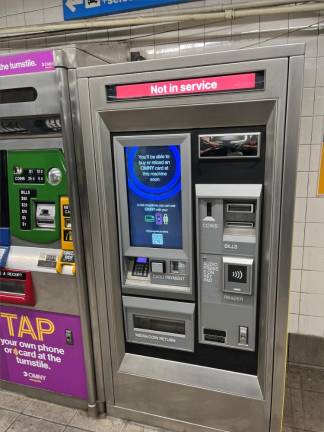What’s the State of Mass Transit on the East Side?
OUR TOWN had an exclusive subway ride with Richard Davey, President of New York City Transit, and Assemblyman Alex Bores on the progress of everything from combatting fare evasion, to new turnstiles, OMNY vending machines, and cameras on buses. And how is that freebie Manhattan cross town bus route doing?




After 18 months on the job, President Richard Davey rode along with an OUR TOWN reporter to assess what has been done and what needs to be done to insure better transit for everyone. During the hour-long conversation and ride, from East 86th Street to the Grand Central #7 platform, President Davey talked about the present structure and future transit plans.
The New York City Transit Authority is the nation’s largest transit system, Davey said to Our Town and the MTA recently announced it reached it served one billion riders this year.
“Right now, we are seeing weekday ridership on Tuesdays, Wednesdays and Thursdays at over 4.5 million riders, with Mondays and Fridays about 10 percent less.”
“During those three midweek days, the bus system is looking at 2.5 million riders, with a similar 10 percent drop on Mondays and Fridays,” Davey noted.
Traveling with him was N.Y. State Assemblyman Alex Bores, who has 140,000 constituents in a district that stretches from E. 32nd St. to E. 94th Street.
The East 86th Street Lexington Avenue Station is one of the first to have an OMNY vending machine. With it, one can buy or reload an OMNY card. Utilizing tap-and-go payment, you can buy and reload at the subway station just like MetroCard. This machine is part of a pilot project.
Ridership for the Lexington Avenue/86th Street 4/5/6 Station averages over 32,000 turnstile payments; it’s newer neighbor, the 86th St. and 2nd Avenue Q train stop averages about 16,500 swipes. These are part of an overall two million swipes in Manhattan. Lexington Avenue stations between 125th Street and 42nd street handle almost 300,000 people paying their fares every day.
AI is now part of the Transit Authority’s operations. Some of the TA’s 5800 buses now have an AI system utilizing hundreds of thousands of bus sensors that are able to detect a problem, hopefully before a bus breaks down and a repair plan can be forwarded to bus mechanics, Davey noted.
AI use on the subway is different. The MTA is quietly using artificial intelligence, monitoring turnstile-jumping at some subway stations.
Davey noted that current statistics point to a current subway fare evasion rate of 14 percent, with a staggering bus nonpayment rate of 41 percent, and almost 50 percent on the SBS buses in the Third Quarter of this year. The NYC Transit Authority lost almost $700 million in fares last year with fare evaders,
Technology is coming to the rescue for subway lines. Earlier this year, a pilot of wide-aisle gates at Atlantic Av-Barclays Center subway station in March 2023; last week, the MTA announced new wide-aisle fare gates at Sutphin Boulevard–Archer Avenue–JFK Airport Station in Jamaica, Queens. The new faregates replace the emergency exit gate at that end of the station. a major contributor to subway fare evasion. The wide-aisle design of the new faregates allows customers with strollers, wheelchairs, and luggage to smoothly enter the system. Should the implementations work, this technology will be used on the subway system, Davey said.
Ensuring less fare evasion on Transit Authority buses will require different resources. A blue ribbon MTA panel in its May 2023 report on fare evasion evaluated how to stop it across the network; buses, given the large percentages of non -payers traveling presented a different solution. With the complete advent of the OMNY fare collection system, the panel proposed moving the Eagle Teams, now used on SBS buses, to local buses, with spot checking. There would need to be 400 officers on staff, a third more than currently on staff, and better onboard validation devices than currently used to summonse repeat offenders,
Current bus schedules in Manhattan are turtle-like. Making timings better requires using bus lanes, and a new system—automated bus lane enforcement (ABLE) cameras to capture drivers violating busway and bus lane rules in real-time should help. Currently, the MTA has almost 600 buses equipped with ABLE cameras on 20 routes across all five boroughs of NYC.
Davey noted, “New bus camera installations will be able to ticket people double parking at bus stops, near them, and in the bus lanes,. 33 percent of our buses will be equipped with cameras.” He went on to say that this is a 4 year pilot program.
At the end of the discussion, Davey gave OUR TOWN an exclusive.“The pilot project for the five bus lines, one in each borough that are free to all riders until March 2024, we are noticing a seven to 20 increase in ridership,” he said. Manhattan’s M116, which connects East Harlem with the Upper West Side, is Manhattan’s free line,